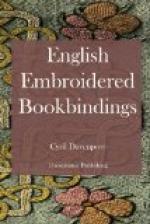It is bound in canvas, and measures 5-3/4 by 4 inches, the groundwork being broadly worked in tapestry-stitch, or some stitch analogous to it, in red silk, resembling in method the work on the ground of The Miroir of the Synneful Soul already described. On this, in the centre of each side, is a large monogram worked in blue silk, interwoven with silver thread, containing the letters K, probably standing for Katherine, A, F, H, and R, possibly meaning ‘Anglie, Francie, Hibernieque, Reginae,’ but like most monograms this one can doubtless be otherwise interpreted. Above and below the monogram are smaller H’s, worked in red silk, interwoven with gold thread. In each corner is a heartsease of yellow and purple silk, interwoven with gold thread, and having small green leaves between each of the petals. The work which was once on the back is now so worn that it cannot be traced sufficiently to tell what it originally was. The designs of these two volumes, credited to the Princess Elizabeth, resemble each other to some extent; they both have a monogram in the centre, they both have heartsease in the corners and groundwork of a like character. They are, as far as workmanship goes, still more alike, similar thick silk is used for the ground, and threads and braids of a thick nature, with metal interwoven, are used on both for the ornamental work. Speaking of this British Museum book, the Countess of Wilton says, ’there is little doubt that Elizabeth’s own needle wrought the ornaments thereon.’
Books embroidered by the Princess Elizabeth.
It cannot be said that there is any actual authority for saying that the two covers just described are really the work of Elizabeth’s own hand, although she is known to have been fond of embroidery, it being recorded that she made and embroidered a shirt for her brother Edward when she was six. There is little doubt, however, that the same designer and the same workwoman worked both these covers, and the technique, as well as the design, are peculiar for the time in which they were done. Canvas bindings were rare—most of the embroidered work on books of that period were splendid works on velvet—so that if these two manuscripts had been ‘given out’ to be bound in embroidered covers we should have expected to find them in rich velvet, like Brion’s Holy Land, or Christopherson’s Historia Ecclesiastica, instead of a very elementary braid work. Without attaching too much importance to the various statements concerning their royal origin, I am inclined to think that there is no impossibility, or even improbability, in the supposition that the Princess designed and worked them herself, thereby adding to her exquisite manuscript the further charm of her clever needle. The idea of both writing and embroidering such valued presents as these two books must have been is likely to have strongly appealed to an affectionate and humble daughter, and there is an artistic completeness in the idea which, I think, tells strongly in its favour.




